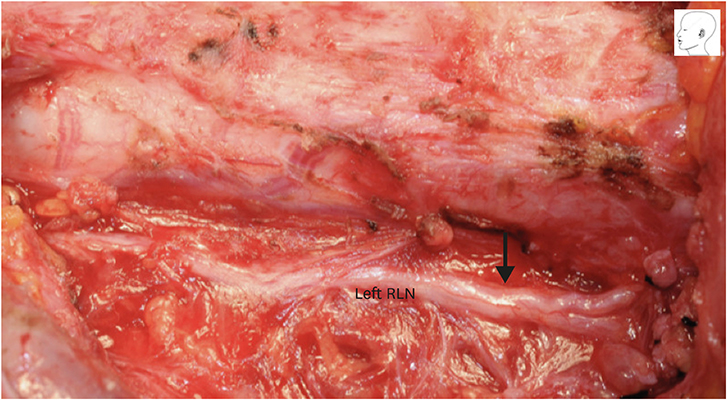J Endocr Surg.
2019 Sep;19(3):88-93. 10.16956/jes.2019.19.3.88.
It Sometimes Happens: Staging Surgery in Coexisting Graves' Disease and Thyroid Cancer
- Affiliations
-
- 1Division of Endocrine and Minimally Invasive Surgery, Department of Human Pathology in Adulthood and Childhood “G. Barresiâ€, University Hospital G. Martino, University of Messina, Messina, Italy. ettore_caruso@hotmail.it
- KMID: 2458707
- DOI: http://doi.org/10.16956/jes.2019.19.3.88
Abstract
- Thyroidectomy is a safe procedure often performed either for benign or malignant thyroid diseases. Complication rate is low and bilateral recurrent laryngeal nerve (RLN) injury associated with thyroidectomy is rarely described. The RLN may be injured bilaterally and damage is usually recognized postoperatively. With an increased use of intraoperative neural monitoring (IONM), an adaptation of the resection strategy appears to be necessary in case of an intraoperative loss of signal of the first operated side with total thyroidectomy planned. We review a case of a 21-year-old female with a history of Graves' disease who underwent a total thyroidectomy in a 2-stage procedure due to a loss of RLN function detected intraoperatively. The patient recovered uneventfully from the 2 surgeries.
MeSH Terms
Figure
Reference
-
1. Schneider R, Randolph GW, Dionigi G, Wu CW, Barczynski M, Chiang FY, et al. International neural monitoring study group guideline 2018 part I: Staging bilateral thyroid surgery with monitoring loss of signal. Laryngoscope. 2018; 128:Suppl 3. S1–S17.
Article2. Schneider R, Lorenz K, Sekulla C, Machens A, Nguyen-Thanh P, Dralle H. Surgical strategy during intended total thyroidectomy after loss of EMG signal on the first side of resection. Chirurg. 2015; 86:154–163.
Article3. Dralle H, Schneider R, Lorenz K, Phuong NT, Sekulla C, Machens A. Vocal cord paralysis after thyroid surgery: current medicolegal aspects of intraoperative neuromonitoring. Chirurg. 2015; 86:698–706.4. Pemberton JD. Exophthalmic goiter: indications for the stage-operation. Arch Surg. 1929; 18:735–744.5. Randolph GW, Dralle H. International Intraoperative Monitoring Study Group. Abdullah H, Barczynski M, Bellantone R, et al. Electrophysiologic recurrent laryngeal nerve monitoring during thyroid and parathyroid surgery: international standards guideline statement. Laryngoscope. 2011; 121:Suppl 1. S1–S16.
Article6. Dralle H, Sekulla C, Lorenz K, Nguyen Thanh P, Schneider R, Machens A. Loss of the nerve monitoring signal during bilateral thyroid surgery. Br J Surg. 2012; 99:1089–1095.
Article7. Sadowski SM, Soardo P, Leuchter I, Robert JH, Triponez F. Systematic use of recurrent laryngeal nerve neuromonitoring changes the operative strategy in planned bilateral thyroidectomy. Thyroid. 2013; 23:329–333.
Article8. Sun H, Wu CW, Zhang D, Makay Ö, Zhao Y, Carcofaro P, et al. New paradigms for neural monitoring in thyroid surgery. Surg Technol Int. 2019; 34:79–86.9. Dionigi G, Frattini F. Staged thyroidectomy: time to consider intraoperative neuromonitoring as standard of care. Thyroid. 2013; 23:906–908.
Article10. Dralle H, Sekulla C, Lorenz K, Nguyen Thanh P, Schneider R, Machens A. Loss of the nerve monitoring signal during bilateral thyroid surgery. Br J Surg. 2012; 99:1089–1095.
Article11. Zhou L, Dionigi G, Pontin A, Pino A, Caruso E, Wu CW, et al. How does neural monitoring help during thyroid surgery for Graves' disease? J Clin Transl Endocrinol. 2018; 15:6–11.
Article12. Schneider R, Lorenz K, Sekulla C, Machens A, Nguyen-Thanh P, Dralle H. Surgical strategy during intended total thyroidectomy after loss of EMG signal on the first side of resection. Chirurg. 2015; 86:154–163.
Article13. Melin M, Schwarz K, Lammers BJ, Goretzki PE. IONM-guided goiter surgery leading to two-stage thyroidectomy--indication and results. Langenbecks Arch Surg. 2013; 398:411–418.
Article14. Kim HY, Sun H, Chai YJ, Tufano R, Dralle H, Navarra G, et al. Loss of the neuromonitoring signal on the first side in planned total thyroidectomy. J Endocr Surg. 2017; 17:89–95.
Article15. American Thyroid Association (ATA) Guidelines Taskforce on Thyroid Nodules and Differentiated Thyroid Cancer. Cooper DS, Doherty GM, Haugen BR, Kloos RT, Lee SL, et al. Revised American Thyroid Association management guidelines for patients with thyroid nodules and differentiated thyroid cancer. Thyroid. 2009; 19:1167–1214.
Article16. Tufano RP, Noureldine SI, Angelos P. Incidental thyroid nodules and thyroid cancer: considerations before determining management. JAMA Otolaryngol Head Neck Surg. 2015; 141:566–572.17. Bainbridge D, Martin J, Arango M, Cheng D. Evidence-based Peri-operative Clinical Outcomes Research (EPiCOR) Group. Perioperative and anaesthetic-related mortality in developed and developing countries: a systematic review and meta-analysis. Lancet. 2012; 380:1075–1081.
Article18. Erdem E, Gülçelik MA, Kuru B, Alagöl H. Comparison of completion thyroidectomy and primary surgery for differentiated thyroid carcinoma. Eur J Surg Oncol. 2003; 29:747–749.
Article19. Dionigi G, Boni L, Rovera F, Rausei S, Castelnuovo P, Dionigi R. Postoperative laryngoscopy in thyroid surgery: proper timing to detect recurrent laryngeal nerve injury. Langenbecks Arch Surg. 2010; 395:327–331.
Article
- Full Text Links
- Actions
-
Cited
- CITED
-
- Close
- Share
- Similar articles
-
- Preoperative Staging of Well Differentiated Thyroid Cancer: US Is Enough?
- Three Cases of Papillary Thyroid Carcinoma Coexistent with Graves' Disease
- Carcinoma of the thyroid gland in patients with Graves' disease
- Graves' Disease that Developed Shortly after Surgery for Thyroid Cancer
- Preoperative Staging of Thyroid Cancer by Ultrasonography




